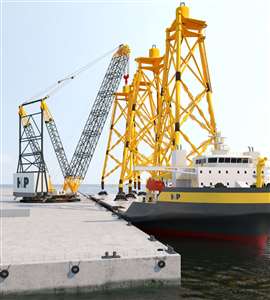How ring cranes can save money in offshore construction
07 July 2023
Adopting a new approach to marshalling and load-out of windfarm jackets could cut logistics costs for project developers by as much as 60 per cent, according to analysis by heavy lift and transportation company Heavy Lift Projects (HLP).
 HLP has modelled the combination of its fully electric ring cranes and a DP flat deck carrier for transport of windfarm jackets. (Photo: HLP)
HLP has modelled the combination of its fully electric ring cranes and a DP flat deck carrier for transport of windfarm jackets. (Photo: HLP)
The company said that until now, developers have used a combination of available crane capacity with tugs and barges to load out jackets for installation by heavy lift vessels.
In the near future, contractors and developers will need much more lifting and marshalling capacity, as well as cargo vessels and support equipment to meet projected windfarm demand.
Fully electric
HLP has modelled the combination of its next-generation fully electric ring cranes to handle the components at the marshalling port on to a dynamically-positioned (DP) flat deck carrier for transport of jackets to the install vessel, a combination that could save up to 60 % of the cost compared to current approaches, the company said.
Using the HLP ring crane enables more efficient pre-assembly handling of jackets on the quayside, as the unit is capable of lifting 5,000 tonnes to the centre of a flat deck carrier allowing loading in and out during any tide and with a favourable weather range compared to a barge or RoRo.
Reduced trips
Using a single, larger DP flat deck carrier would reduce trips to site due to increased carrying capacity when compared to using a north sea barge.
HLP predicts that transport to the install vessel will also be accomplished at higher speed compared to using barges and tugs, reducing further the installation schedule timeline.
The DP flat deck carrier can operate in a larger weather window, with reduced risk of offshore collision. Ancillary costs for ongoing storage, port fees, fuel, mobilisation, handling and standby of barges and tugs are also reduced.
“The demand for marshalling of jackets, which have grown in size from 1,000 tonnes to almost 5,000 tonnes presents a real opportunity to think laterally about saving cost and timelines as well as reducing risk,” said HLP managing director Alex Fyfe. “The HLP approach is evolutionary; though it does reflect the need for change in windfarm marshalling; I think we have to ask why we still using a 19th century solution for a 21st century industry.”
Large investment
HLP was founded in 2021 and is backed by Capercaillie Investments and Giles W Pritchard-Gordon & Co which have committed a multi-million pound investment to complete engineering work on its first project, a new design of ring crane for assembling and loading offshore windfarm components.
STAY CONNECTED


Receive the information you need when you need it through our world-leading magazines, newsletters and daily briefings.
CONNECT WITH THE TEAM








